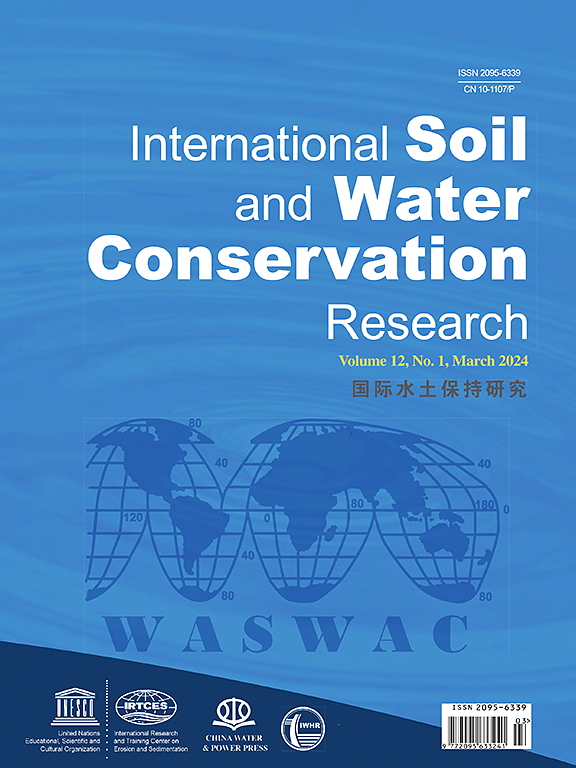Exploring soil erosion and reservoir sedimentation through the RUSLE model and bathymetric survey
IF 7.3
1区 农林科学
Q1 ENVIRONMENTAL SCIENCES
International Soil and Water Conservation Research
Pub Date : 2024-10-22
DOI:10.1016/j.iswcr.2024.10.005
引用次数: 0
Abstract
The aim of the paper was to compare the soil erosion in a river catchment with the sediment volume accumulated at the river mouth. Firstly, the sediment yield was estimated in GIS based on the soil loss according to the RUSLE model, and then further integrated into the sediment production equation. Following this, we estimated the sediment volume accumulated at the river mouth based on the diachronic overlap of topographic and bathymetric data. This methodology was validated for the Eselnita catchment exiting into the Iron Gates I Reservoir. The LS factor has an average value of 4, with lower values for the forest cover. The C factor has an average value of 0.057 being statistically correlated with the RUSLE result. The average soil loss was estimated at approximately 1.89 t ha−1 yr −1, a value that is validated by previous studies as a low risk of erosion at national scale. The sediment transfer model indicates a distribution of cells sediment production strongly correlated with the time travel to the discharge channels. Overall, the sediment volume obtained by using the RUSLE model corresponds to about 70% of the sediment volume accumulated at the river mouth during 53 years (1970–2022). The difference in sedimentation may be due to human activities along the river mouth's banks to extend the built-up area and to enjoy the waterscape. This paper is relevant for the topic of reservoir sedimentation and recommends the use of the RUSLE model to predict the sediment contribution, especially for small ungauged catchments.
通过RUSLE模型和水深测量探索土壤侵蚀和水库沉积
本文的目的是比较河流流域的土壤侵蚀与河口的泥沙蓄积量。首先,根据RUSLE模型在GIS中基于土壤流失量估算出产沙量,然后将产沙量进一步整合到产沙方程中。在此基础上,基于地形和水深资料的历时重叠,估算了河口沉积量。该方法在Eselnita集水区进入铁门1号水库的情况下得到了验证。LS因子的平均值为4,森林覆盖的LS因子值较低。C因子均值为0.057,与RUSLE结果有统计学相关性。据估计,平均土壤流失量约为1.89吨/公顷- 1年- 1年,这一数值已被先前的研究证实为全国范围内的低侵蚀风险。泥沙输运模型表明,细胞产沙量的分布与排水渠的时间旅行密切相关。总体而言,RUSLE模型得到的沙体积相当于53 a(1970-2022)河口累积沙体积的70%左右。沉积物的差异可能是由于人类在河口沿岸的活动,以扩大建成区和享受水景。本文与水库沉积有关,并建议使用RUSLE模型来预测泥沙贡献,特别是对于未测量的小集水区。
本文章由计算机程序翻译,如有差异,请以英文原文为准。
求助全文
约1分钟内获得全文
求助全文
来源期刊

International Soil and Water Conservation Research
Agricultural and Biological Sciences-Agronomy and Crop Science
CiteScore
12.00
自引率
3.10%
发文量
171
审稿时长
49 days
期刊介绍:
The International Soil and Water Conservation Research (ISWCR), the official journal of World Association of Soil and Water Conservation (WASWAC) http://www.waswac.org, is a multidisciplinary journal of soil and water conservation research, practice, policy, and perspectives. It aims to disseminate new knowledge and promote the practice of soil and water conservation.
The scope of International Soil and Water Conservation Research includes research, strategies, and technologies for prediction, prevention, and protection of soil and water resources. It deals with identification, characterization, and modeling; dynamic monitoring and evaluation; assessment and management of conservation practice and creation and implementation of quality standards.
Examples of appropriate topical areas include (but are not limited to):
• Conservation models, tools, and technologies
• Conservation agricultural
• Soil health resources, indicators, assessment, and management
• Land degradation
• Sustainable development
• Soil erosion and its control
• Soil erosion processes
• Water resources assessment and management
• Watershed management
• Soil erosion models
• Literature review on topics related soil and water conservation research
 求助内容:
求助内容: 应助结果提醒方式:
应助结果提醒方式:


